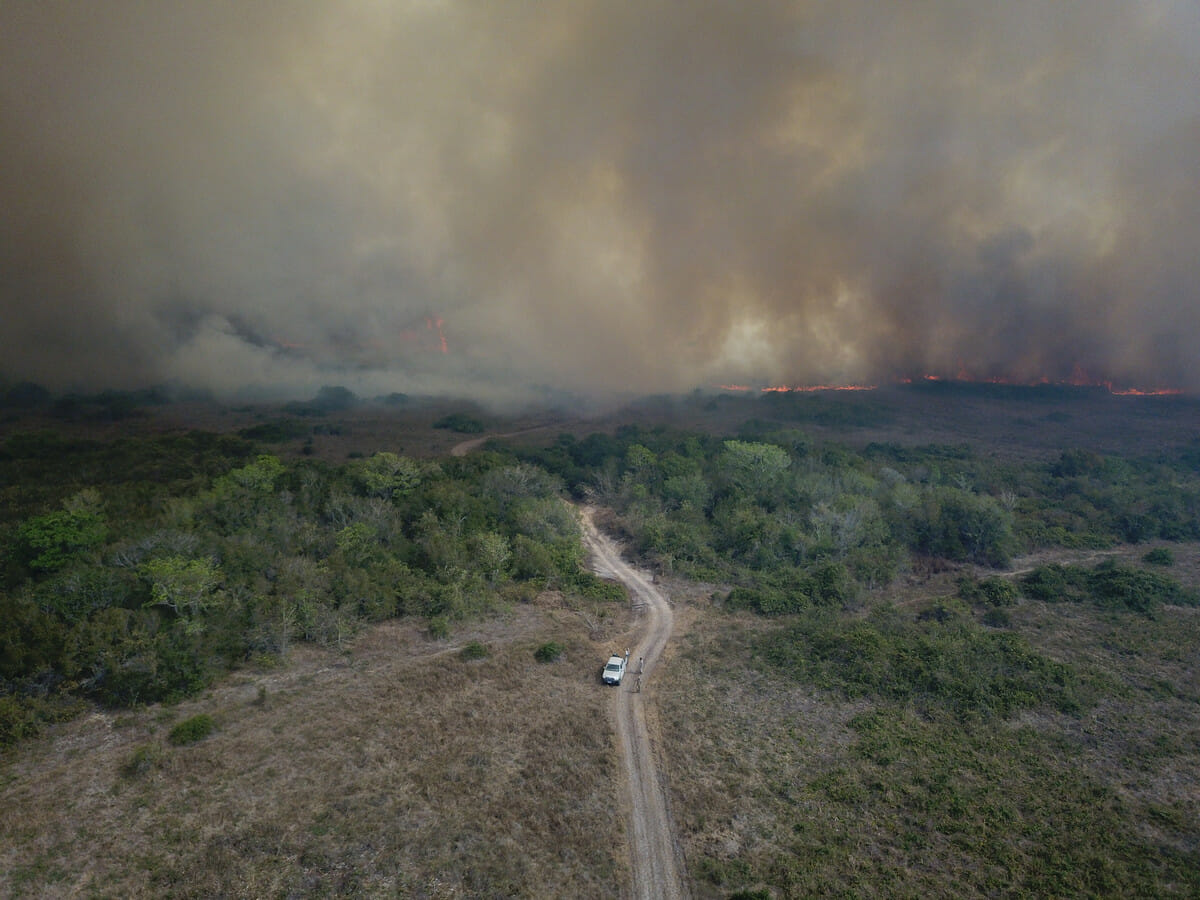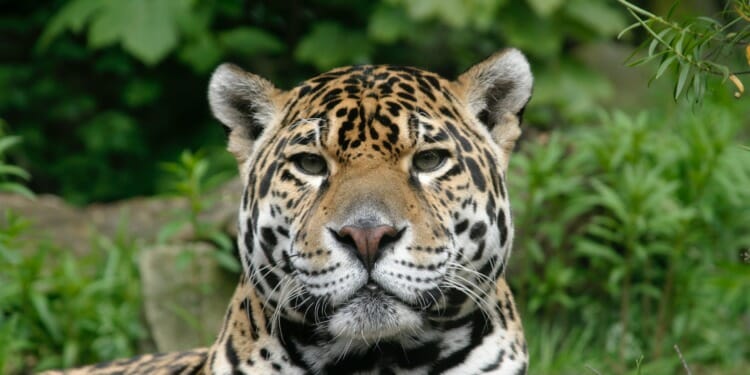The jaguar is an iconic species. As the largest cat in the Americas and a key fixture throughout centuries of Indigenous culture, the jaguar is a symbol of the land it lives upon. Yet for a creature that can crush the skull of a crocodile in its jaws, it’s incredibly vulnerable.
Spurred on by severe drought, wildfires have blazed through the Pantanal and Amazon region where the cats live. A staggering 1,470 jaguars are estimated to have been killed or displaced in recent years according to Fernando Tortato, a Conservation Scientist at Panthera, an organisation working to conserve wild cat species.
“That’s approximately 300 jaguars a year!” Tortato exclaims. Unfortunately, “recovering this displaced jaguar population is an impossible task for the simple reason that the habitat that supported this top predator no longer exists. Reverse the reasoning and imagine if it would be possible to repopulate the Amazon with 300 jaguars a year with the available scientific tools? The answer is a resounding no.”
The necessary science and environment just don’t exist — a fate which may engulf the species as a whole as populations are declining faster than we can save them. 1,470 jaguars is an inexcusable figure on a moral level, but it’s also dangerous in other regards.
Tortato goes on to explain that the jaguar isn’t just an icon, it’s “considered an umbrella species. Actions for its conservation ensure the protection of biodiversity as a whole in the Amazon and Pantanal. Its presence in the Amazon or Pantanal indicates an ecosystem robust enough to maintain the needs of a large predator. A forest without its top predator loses its balance.”
It’s not just “an ecological loss,” as Tortato puts it. It’s also a cultural loss:
“…for the Pantanal in particular, it is also an economic loss, as the jaguar is one of the main species tourists flock to see in its natural habitat.”
Unfortunately the cultural, ecological and economic significance of the jaguar is not enough to save it. Thousands are being displaced by deforestation, fires, and lack of governance. The species are currently considered near threatened by the International Union for the Conservation of Nature (IUCN). At the time of writing, this status is under review and may soon be pushed to “vulnerable.”
I asked Tortato if there is a chance that deforestation and wildfires in the region will further threaten its status, potentially tipping the species towards functional extinction where populations are too small to recover or provide ecosystem services.
“This is exactly the path that jaguar populations in the Atlantic Forest, Cerrado, and Caatinga have followed in Brazil,” Tortato told me. “In these three biomes, we have isolated jaguar populations mainly in protected areas where the estimates of the size of their populations are not at all optimistic.”
However, as Tortato explains, “the Amazon, with its size, still allows jaguar populations to follow another path, with more hope for long-term conservation of the species.” If we are to save jaguar populations in the Amazon though, we need to address the fires.

Severe drought is exacerbating wildfires, allowing them to burn further and faster than before. Natural barriers such as rivers and swamps that would normally protect against fires have dried out. A cruel cycle appears where climate change intensifies wildfires which in turn devastate ecosystems preventing them from performing the key services that stabilise and mitigate climate change.
As the drought has continued and intensified, the wildfires are claiming more ground and more lives. Late last year it was estimated that more than a third of the Pantanal was burning, affecting 600 jaguars. As scientists turned into firefighters, local communities rushed to save the wildlife that managed to crawl out of the flames, such as the jaguar named Gloria in the video below.
Gloria managed to escape with only badly burnt paws and is already recovering. However, others in the area and the generations that follow her may not be so lucky.
Although “Government representatives, NGOs, and farmers are hyper-aware of this issue,” and are collaborating to avoid more fires like those in 2020, Tortato affirms that more must be done: “We have to study and openly discuss within society how to strategically and properly manage these fires, including how to monitor fires and implement consequences for those who improperly set them.”
The situation in the neighbouring Amazon is different. As Tortato points out, “It is easy to criticize the deforestation of the Amazon but not understand the economic reasons behind this deforestation.” The culpability of these fires and environmental degradation is not restricted to local communities, businesses and governance. Consumption of beef and soy (largely produced for animal feed) are closely linked to the “loss of jaguar habitat in the tropics.”
The deaths and displacement of these 1,470 jaguars cannot be disentangled from the lives and consumption habits of those in the West some 5000 miles away. According to Tortato, “Reducing meat consumption and demanding the legal origin of the product from food production companies is a duty of citizens who care about biodiversity.”
Although more and more people are adopting sustainable or vegan diets and heads of states have formally agreed to end deforestation by 2030, more urgent action is still needed if we want to protect jaguar populations, and their ecosystems, from collapse.
Panthera, composed of scientists like Tortato, is providing that action.
Related Articles: Pantanal, the World’s Biggest Wetland, is on Fire – Why You Need to Worry | The Battle for the Amazon Rainforest: Are the “Lungs of the Earth” Collapsing?
What is Panthera doing to conserve the jaguar?
Pantheria is currently the only organization in the world that is exclusively devoted to the conservation of the world’s wild cats. It’s also running the only conservation programme that protects jaguars “across their six million km2 range” — the Jaguar Corridor Initiative.
This initiative works in “partnership with governments, corporations, and local communities” to “preserve the genetic integrity of the jaguar by connecting and protecting core jaguar populations in human landscapes from northern Mexico to Argentina.”
Panthera’s scientists have mapped out the presence and movement of jaguars in 11 different countries and then partnered with governments and corporations “to support land developments that are both economically profitable and ecologically sustainable, allowing safe passage for jaguars and other wildlife.”
The vulnerability of jaguars is compounded by cattle ranching. If it doesn’t burn down their habitats, it puts them under more direct threat as ranchers seek to “protect their cattle from jaguar attacks”. In fact, Tortato says that this is “One of the biggest threats jaguars face.”
Panthera scientists have come up with innovative ways to “mitigate human-jaguar conflict surrounding livestock predation by training ranchers in anti-predator husbandry techniques, such as building predator-proof enclosures.” Tortato adds that “Panthera’s field teams also educate local communities about the overhunting of jaguar prey species, which encourages livestock predation.”
To further these efforts, Panthera purchased the Jofre Velho Ranch in 2014 protecting 25,000 acres of land in the Pantanal. The aim here was to lead by example as the conservationist explains “By implementing anti-predation techniques championed by our Conflict Program Director Rafael Hoogesteijn, we converted the Jofre Velho Ranch into our demonstration ranch to show ranchers how to protect their cattle.”
The list of threats to jaguars go on and on, which is why Panthera is taking an expansive and long-term approach to protecting the species. “At Panthera, we know one of the best ways to conserve animals is to make them a benefit to the community,” Tortato explains. That’s why the organisation is working with ecotourism guides to ensure that tours can provide plentiful opportunities for tourists to see jaguars whilst also ensuring the safety of the animals.
“We provided guidance on how many boats can be on the river at once, how to behave when near a jaguar, and how far away from a jaguar to stay,” Tortato continues. “We also teach tour operators information about wildlife and give them language lessons to make tours more fun, informative, and accessible.”
Additionally, Panthera opened a school in the Pantanal in 2012 to educate children education incorporating “information about local ecology and culture” in an innovative curriculum. At the same time, a night school teaches literacy to adults and the community as a whole appreciates that jaguars are responsible for these services.
Panthera understands that the long-term conservation of jaguars cannot be ensured if humans in the area do not know how to co-exist with them. Thanks to the conservation group, the jaguar is seen as a valuable asset in the region and the communities there now know how best to conserve populations.
It’s clear that Panthera are doing all that they can to protect jaguars as their homes and ecosystems are devastated. The jaguar is an iconic species and the loss of 1,470 of them is just as iconic. Their death and displacement clearly represents a world in which we are pushing nature to its edge. The suffering of these animals have already been silenced by the roar of flames, but scientists like Tortato and others within Panthera refuse to let this story die out.
Action needs to be taken, at state and local levels, by scientists on the ground in Brazil and by individual consumers halfway round the world. None of us want to live in a world without jaguars, so all of us must take action. Support Panthera, adopt an ethical diet or just spread the word by sharing this article. Do something today to save a jaguar tomorrow.
Editor’s Note: The opinions expressed here by Impakter.com columnists are their own, not those of Impakter.com. — In the Featured Photo: A jaguar stares directly at the camera Featured Photo Credit: Ian Keenan










